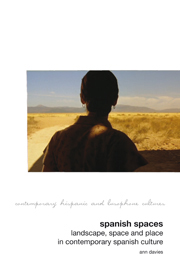Book contents
- Frontmatter
- Contents
- Acknowledgements
- List of illustrations
- 1 Introduction
- 2 Memory: landscapes of the past in Guillermo del Toro's Spanish films
- 3 Forgetting: the landscapes of Gonzalo Torrente Ballester
- 4 Landscape and identities in the Basque Country
- 5 Crime scene: landscape and the law of the land
- 6 Crime, scene, investigation: women, detection and the city
- 7 Coasting: tourism and landscape
- 8 Immigration: north (of) Africa
- 9 Conclusion
- Filmography
- Bibliography
- Index
7 - Coasting: tourism and landscape
- Frontmatter
- Contents
- Acknowledgements
- List of illustrations
- 1 Introduction
- 2 Memory: landscapes of the past in Guillermo del Toro's Spanish films
- 3 Forgetting: the landscapes of Gonzalo Torrente Ballester
- 4 Landscape and identities in the Basque Country
- 5 Crime scene: landscape and the law of the land
- 6 Crime, scene, investigation: women, detection and the city
- 7 Coasting: tourism and landscape
- 8 Immigration: north (of) Africa
- 9 Conclusion
- Filmography
- Bibliography
- Index
Summary
Spain has functioned as a tourist location for outsiders for at least the past two centuries. In the nineteenth century Frenchmen found Spain convivial as the primitive other next door, conveniently just the other side of the Pyrenees but allowing an escape, for a time, from the constraints of polite French society. This included a form of sex tourism, or at the very least an appreciation of maidens duskier than those to be found in France. Joseba Gabilondo observes that in the nineteenth century ‘Southern Europe, in continuation with the lower classes of most Northern European countries and cities, becomes the field in which heterosexuality is “tried out” and learned by young bourgeois men, so as to implement it later back home with women of their same class’ (Gabilondo 2008: 21). Spanish women thus come to represent a sexualised exotic other that nonetheless includes a show of freedom or agency, as Gabilondo goes on to note, ‘The orientalized “independence” of the Spanish woman becomes the sign of her “other sexuality” that is “before” and “outside” French bourgeois heterosexuality’ (ibid.: 27).
One of the most famous outputs of this vein is of course Prosper Mérimée's novella ‘Carmen’ of 1845, which in turn formed the basis of Bizet's opera of 1875: from there the portrait of a free-spirited, fickle and sexually desirable young Gypsy woman became known worldwide (spawning in her turn myriad interpretations of her story: see Powrie at al. 2007).
- Type
- Chapter
- Information
- Spanish SpacesLandscape, Space and Place in Contemporary Spanish Culture, pp. 120 - 141Publisher: Liverpool University PressPrint publication year: 2012

